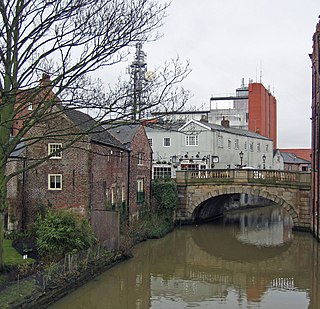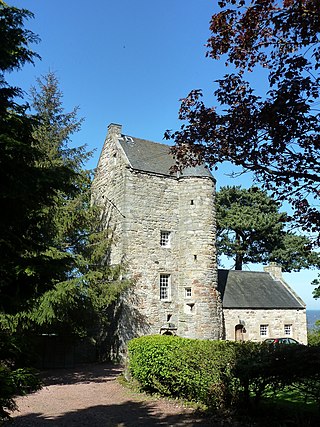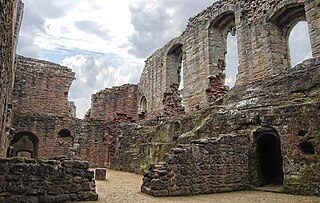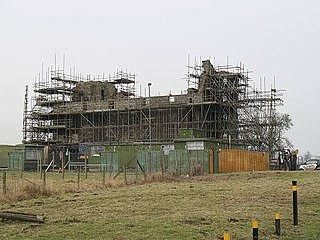
Middleham Castle is a ruined castle in Middleham in Wensleydale, in the county of North Yorkshire, England. It was built by Robert Fitzrandolph, 3rd Lord of Middleham and Spennithorne, commencing in 1190. The castle was the childhood home of King Richard III, although he spent very little of his reign there. The castle was built to defend the road from Richmond to Skipton, though some have suggested the original site of the castle was far better to achieve this than the later location. After the death of King Richard III the castle remained in royal hands until it was allowed to go to ruin in the 17th century. Many of the stones from the castle were used in other buildings in the village of Middleham.

The River Foss is in North Yorkshire, England. It is a tributary of the River Ouse. It rises in the Foss Crooks Woods near Oulston Reservoir close to the village of Yearsley and runs south through the Vale of York to the Ouse in the centre of York. The name most likely comes from the Latin word Fossa, meaning ditch. It is mentioned in the Domesday Book. The York district was settled by Norwegian and Danish people, so parts of the place names could be old Norse. Referring to the etymological dictionary "Etymologisk ordbog", ISBN 82-905-2016-6 deals with the common Danish and Norwegian languages – roots of words and the original meaning. The old Norse word Fos (waterfall) means impetuous. The River Foss was dammed, and even though the elevation to the River Ouse is small, a waterfall was formed. This may have led to the name Fos which became Foss.

Sandgate Castle is an artillery fort originally constructed by Henry VIII in Sandgate in Kent, between 1539 and 1540. It formed part of the King's Device programme to protect England against invasion from France and the Holy Roman Empire, and defended a vulnerable point along the coast. It comprised a central stone keep, with three towers and a gatehouse. It could hold four tiers of artillery, and was fitted with a total of 142 firing points for cannon and handguns.

Hylton Castle is a stone castle in the North Hylton area of Sunderland, Tyne and Wear, England. Originally built from wood by the Hilton family shortly after the Norman Conquest in 1066, it was later rebuilt in stone in the late 14th to early 15th century. The castle underwent major changes to its interior and exterior in the 18th century and it remained the principal seat of the Hylton family until the death of the last Baron in 1746. It was then Gothicised but neglected until 1812, when it was revitalised by a new owner. Standing empty again until the 1840s, it was briefly used as a school until it was purchased again in 1862. The site passed to a local coal company in the early 20th century and was taken over by the state in 1950.

Alnham is a hamlet and civil parish in Northumberland, England. It is about 14 miles (23 km) west of Alnwick, about 6 miles (9.7 km) from Scotland and is located on the south of a small tributary of the River Aln. The village stands on uneven ground, sloping from south to north, at the foot of the southern outliers of the Cheviot Hills. The River Aln flows eastward through the village from its source in the Cheviot Hills down to the coast. The layout of the village appears to have been dictated by the river. The estimated population taken at the 2011 Census was around 245.

A gatehouse is a type of fortified gateway, an entry control point building, enclosing or accompanying a gateway for a town, religious house, castle, manor house, or other fortification building of importance. Gatehouses are typically the most heavily armed section of a fortification, to compensate for being structurally the weakest and the most probable attack point by an enemy. There are numerous surviving examples in France, Austria, Germany, England and Japan.

Crayke is a village and civil parish in North Yorkshire, England, about 2 miles (3.2 km) east of Easingwold.

Wressle Castle is a ruined palace-fortress in the East Riding of Yorkshire, England, built for Thomas Percy in the 1390s. It is privately owned and it is usually open to the public for a few days each year. Wressle Castle originally consisted of four ranges built around a central courtyard; there was a tower at each corner, and the structure was entered through a gatehouse in the east wall, facing the village.

Howden Minster is a large Grade I listed Church of England church in the Diocese of York. It is located in Howden, East Riding of Yorkshire, England and is one of the largest churches in the East Riding. It is dedicated to St Peter and St Paul and it is therefore properly known as 'the Minster Church of St Peter and St Paul'. Its Grade I listed status also includes the Chapter House.

South Cowton Castle is a 15th-century fortified dwelling house in the Richmondshire district of North Yorkshire, England. It is situated on the land that was once the medieval village of South Cowton.

Hawthornden Castle is located on the River North Esk in Midlothian, Scotland. The castle lies a mile to the east of Roslin at grid reference NT287637, and is just downstream from Roslin Castle. Hawthornden comprises a 15th-century ruin, with a 17th-century L-plan house attached. The house has been restored and now serves as a writer's retreat. Man-made caves in the rock beneath the castle have been in use for much longer than the castle itself.

Cramond Tower is a fifteenth-century tower house in the village of Cramond to the north-west of Edinburgh, Scotland.

Burg Krems is a castle in Styria, Austria. Burg Krems is 330 metres (1,080 ft) above sea level.

Spofforth Castle in the village of Spofforth, North Yorkshire, England was a fortified manor house, ruined during the English Civil War and now run by English Heritage as a tourist attraction.

Holy Trinity Church is a redundant Anglican church on Low Lane in the village of Wensley, North Yorkshire, England. The building is recorded in the National Heritage List for England as a designated Grade I listed building, and is under the care of the Churches Conservation Trust. Alec Clifton-Taylor included the church in his list of 'best' English parish churches.

Rochester Castle stands on the east bank of the River Medway in Rochester, Kent, South East England. The 12th-century keep or stone tower, which is the castle's most prominent feature, is one of the best preserved in England or France.

Paull Holme Tower is an unusual late-medieval fortified tower in the East Riding of Yorkshire, England.

Duntarvie Castle is a ruined Scots Renaissance house in West Lothian, Scotland. It is located 1.5 kilometres (0.93 mi) north of Winchburgh and 9 kilometres (5.6 mi) east of Linlithgow, close to the M9 motorway. Constructed in the late 16th century, the building has been undergoing restoration since the 1990s. The house is protected as a category A listed building, and a scheduled monument.

Pencoed Castle is a ruined Tudor mansion, largely dating from the 16th century, in the parish of Llanmartin, now within the city of Newport, south Wales. It is located about 0.5 miles (0.80 km) east of Llanmartin village, and 0.5 miles (0.80 km) south-east of Llandevaud, at the end of a farm lane.

Castle Kennedy is a ruined 17th-century tower house, about 3 miles (4.8 km) east of Stranraer, Dumfries and Galloway, Scotland, around 0.5 miles (0.80 km) north of the village of Castle Kennedy.




















